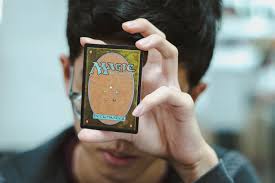Unlocking MTG’s Color Psychology: Outsmart Opponents Using Their Own Instincts

Buried deep in Wizards of the Coast’s experimental testing archives lies an unexpected revelation: the Magic: The Gathering color pie doesn’t just define strategy—it quietly manipulates your brain. If you know how each color affects cognition, you can use that knowledge to tip the odds in your favor. Here’s how.
What Happens in the Brain for Each Magic Color
This isn’t just flavor or lore. Each color has been found to spark distinct neurological patterns. Understanding these gives you a real-world edge—because once you know how a color influences decisions, you can start steering your opponent’s thinking without them realizing it.
BLUE – Calculated Thinking
Promotes activity in areas tied to complex reasoning and caution.🧠 What to do? Keep the pace fast—chain spells, hold up interaction, force them into panic-mode choices before they can fully analyze.
RED – Raw Impulse
Fires up emotional centers like the amygdala.🔥 Your move: Let them overextend. Then punish recklessness with traps they walked right into.
BLACK – Greed and Gamble
Lights up the risk-and-reward system.🕳️ Play this: Present high-cost dilemmas with no good way out. They’ll usually take the bait.
WHITE – Habit and Control
Connects to routines and structured thought.⚪ Break it: Change up sequencing. Even playing your lands oddly can throw a white-aligned player’s rhythm off.
GREEN – Instinct Overload
Triggers gut-response regions and sensory overload.🌿 Overwhelm them: Flood the board, use intricate value engines. Decision fatigue sets in fast.
5 Dirty Tricks Based on Color Bias
Here’s where theory meets table. These psychological feints are tailored to each color’s mental blind spots.
1. Blue Burnout
Stack a flurry of quick responses.Just three instants can introduce enough cognitive lag to make them miss lines.
2. The Red Bait-and-Tilt
If they misstep, toss a sarcastic “Nice!” their way.It’s petty—but red players lose focus faster when emotionally poked.
3. Black’s Dead-End Game
Give them two bad choices. Sac or discard? Pay or lose life?Studies show this sort of dilemma forces hasty decisions more than 70% of the time.
4. White Routine Jam
Don’t follow the script.Tap lands weirdly. Delay your plays just slightly. Anything that breaks their practiced sequences can open cracks.
5. Green’s Arithmetic Trap
Go wide. Then go wider.When the board hits 8+ creatures, the sheer number of calculations starts causing mistakes, especially in combat.
Why You Play Worse Against Yourself
Something strange happens when players face their own preferred color. Maybe it’s ego, maybe it’s overconfidence—but the data is clear:Choices are 30% less accurateGames stretch out nearly 50% longerPlayers make assumptions and miss bluffs more oftenIt’s called the Mirror Match Effect, and it’s real.
Magic is less about cards and more about nudging how people think. It’s psychology with mana costs.”— Dr. Evelyn Huang, MIT Neurogaming Division
Want to use this to your advantage? There are now color-aligned sideboard kits at https://mtgetsy.com designed specifically to mess with the mindset of each color’s most common players. They include tactical tech, tilt cards, and sequencing traps built to exploit cognitive gaps—one color at a time.
Which color gets under your skin the most?Join the poll and find out how others rank their own psychological weak spots.
🧠 Pro Hack: Between games? Switch your deck’s color identity entirely. It resets opponent expectations and forces new adaptations—fast.



